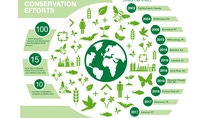Media
BASF expands wildlife conservation efforts
The chemical company helps environment by creating one wildlife habitat at a time.
It all started with creating a landscaping habitat on Fighting Island, Canada in 2002, near BASF’s facility in Wyandotte, Michigan. That was the first conservation project for which BASF achieved the Wildlife Habitat Council’s Conservation Certification (previously called Corporate Lands for Learning and Wildlife Work).
Then, in 2004, the chemical company established nesting boxes for blue birds, owls and bats on its Whitehouse, Ohio site, garnering again the same certification. Later, in 2008, the chemical company developed another wildlife habitat in Rensselear, N.Y., receiving a third certification.
Since then, BASF—which operates more than 100 production and research and development sites throughout North America and has a partnership with WHC—participates in corporate conservation programs at 10 of its sites. And there are 15 more sites in different steps of the process to get certified under WHC.
As a long-time pioneer in developing sustainability efforts, BASF has been creating various wildlife habitats on its corporate sites in an effort to get certified under WHC.
“It’s a third-party recognition of the work that has been and is ongoing,” said John Douglas Reid-Green, Expert for Remediation, BASF. “We can say as much as we want what a great job we’re doing. But having someone from the outside have standards that we’ve demonstratively met allows us to show that we are performing to those standards.”
BASF is certainly not the first company to get certified for creating a wildlife habitat. Last year, CEMEX, the building material company, spent millions towards environmentally friendly actions, including getting all of its U.S. sites certified under WHC. BASF customer Bayer has certified its Pittsburgh site since 1999 and is managed by a 60-member Wildlife Sustainability Team. It maintains a walking trail through the site’s habitats and holds several educational projects. Companies are taking heed of the importance of corporate conservation and are jumping on the bandwagon of ecological sustainability.
The criteria for getting certified entails establishing a wildlife habitat on a company site in the form of landscaping, a forest, wetlands or a cave, just to name a few, according to Sharon Tucker, Environment Health & Safety / Remediation, who was responsible for getting the Florham Park, N.J. campus certified, the headquarters for BASF in North America.
“The idea of tackling something different and learning something new, there’s an excitement about that,” she said. “If the headquarters (Florham Park) is certified then hopefully other sites will take interest.”
The Florham Park campus received certification for planting pollinator gardens that provide food and shelter for bees, butterflies and certain species of birds. The average certification lasts for two to three years, depending on the strength of the program, said Tucker.
Aside from helping the environment and working on something together, companies participating in conservation efforts also educate their employees on best sustainability practices, which helps them use what they’ve learned in their own lives. This is why Tucker heads several lunch and learns at the company throughout the year.
“This is all for employees as part of community engagement,” Tucker added. “The connectivity is they take what they’ve learned home, to grow the program, so to speak.”

Published by Anna Spiewak.
For media inquiries or to repurpose this article, please contact Lisa Brown.